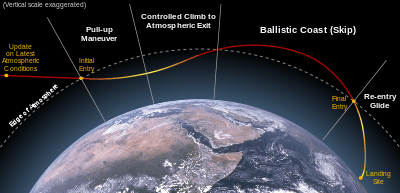Skip reentry

Skip reentry is a reentry technique involving one or more successive "skips" off the atmosphere to achieve greater entry range or to slow the spacecraft before final entry, which helps to dissipate the huge amount of heat that is usually generated on faster descents. The range modulation made possible by skip entry allows a spacecraft to reach a wider landing area, or to reach a designated landing point from a wider range of possible entry times, which is especially important in abort situations. Like aerocapture, skip reentry requires precise guidance. An overly shallow entry angle will result in the spacecraft retaining too much of its velocity, possibly escaping into space permanently if this is more than escape velocity. An overly steep entry, on the other hand, results in more intense heating and stress that could exceed the design limits of the spacecraft, potentially destroying it.
Concept
The basic concept is to 'clip' the atmosphere at such an angle that the spacecraft is 'pushed' back out into space, conceptually similar to a flat stone skipping across the surface of a lake. Each time, the spacecraft's velocity is reduced so that it can eventually drop into the atmosphere at a low suborbital velocity.
In theory, any craft could perform skip re-entry as it does not require much lift, but in practice it requires precise guidance. Although the space shuttle was capable of skip reentry, NASA had carried it out only in computer simulations (Scott Horowitz, NASA interview, Jan. 25, 2007). It is unclear how thermal shielding would have fared under the rapid heating, cooling and reheating. In theory STS-107 might have survived if a skip trajectory had been attempted - giving more time for heat dissipation - but this cannot be proven.
Skip entry was first imagined in the 1930s by Eugen Sänger, who proposed a suborbital skipping trajectory for the German Silbervogel bomber, which never flew.
In practice
The technique was used by the Zond series of circumlunar spacecraft, which planned for one skip before landing. Zond 6, Zond 7 and Zond 8 made successful skip entries, although Zond 5 did not.[1][2] The Apollo Command Module, when returning from the moon, was capable of a one-skip entry. The Orion spacecraft crew module was planned to be capable of skip entry, to allow targeting the landing site from a greater variety of abort trajectories. The Chang'e 5-T1 also used this technique.
Guidance of a skip trajectory can be tricky due to trajectory sensitivity. The Apollo Skip Guidance[3] was engineered, but never utilized in a manned mission. More recent work relies on advances in computing technology to compute a trajectory on board the vehicle.[4][5][6]
Flight mechanics
Using simplified equations of motion and assuming that during the atmospheric flight both drag and lift forces will be much larger than the gravity force acting on the vehicle, the following analytical relations for a skip reentry flight can be derived:[7]

Where gamma is the flight path angle relative to the local horizontal, the subscript E indicates the conditions at the start of the entry and the subscript F indicates the conditions at the end of the entry flight.
The velocity V before and after the entry can be derived to relate as follows:

Where L/D equals the lift to drag ratio of the vehicle.
See also
References
- ↑ http://www.astronautix.com/project/lunarl1.htm
- ↑ The Soviet Space Race with Apollo, Asif Siddiqi, pages 655 and 656
- ↑ Bogner, I. (August 4, 1966). "Apollo Skip Guidance" (PDF). Bellcom.
- ↑ Bairstow, Sarah Hendrickson (2006). Reentry Guidance with Extended Range Capability for Low L/D Spacecraft (PDF) (M.Sc. thesis). Massachusetts Institute of Technology.
- ↑ Brunner, Christopher W.; Lu, Ping (20–23 August 2007). Skip Entry Trajectory Planning and Guidance (PDF). AIAA Guidance, Navigation and Control Conference and Exhibit. Hilton Head, South Carolina.
- ↑ Rea, Jeremy R.; Putnam, Zachary R. (20–23 August 2007). A Comparison of Two Orion Skip Entry Guidance Algorithms (PDF). AIAA Guidance, Navigation and Control Conference and Exhibit. Hilton Head, South Carolina.
- ↑ Mooij, E (2014). Re-entry Systems Lecture Notes. Delft TU.
External links
- Berger, Brian (January 26, 2007). "NASA Studies Early Moon Shot for New Space Capsule". Space.com.
| |||||||||||||||||||||||||||||||||||||||||||||||
